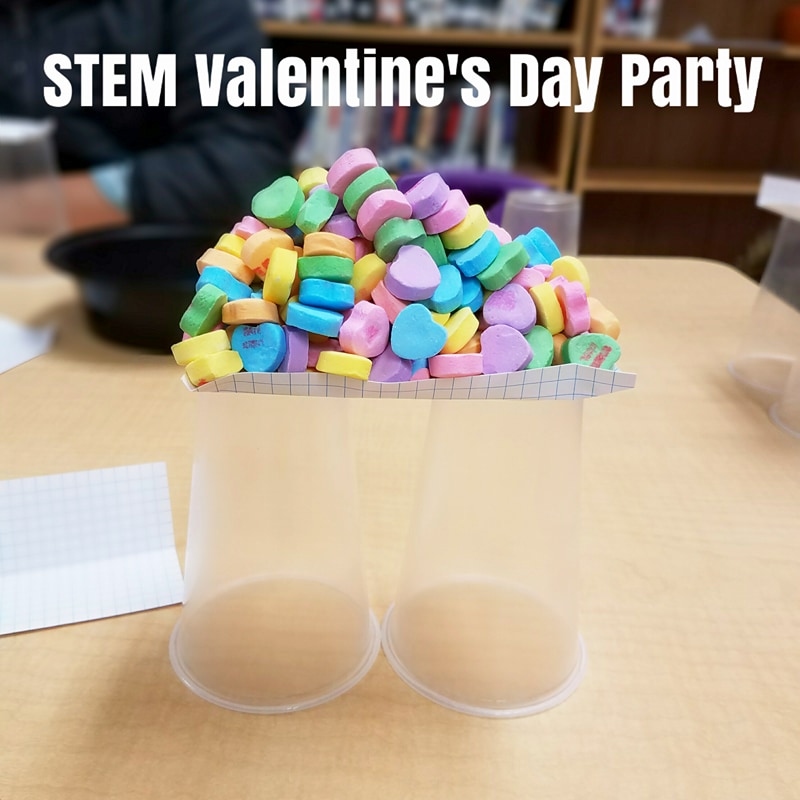Valentine’s Day. For some, just the mention of it brings smiles, for others groans. For myself, I have always appreciated the day as a time to remember family and friends who I care about. And, for the elementary school children who still make Valentine’s day bags and boxes and exchange valentines, it seems that the day is a positive one for them as well. What to do when a library STEM program falls on this special holiday? Plan a Valentine’s Day STEM Party, of course!
The skinny: This was a fun program because I gave myself a constraint: I wanted to create multiple activity stations that all used Valentine’s Day conversation candy hearts. In the end, I was able to design five different activity stations, and after each program, I polled the kids to find out which stations were their favorite. Each station received approximately the same number of votes after running the program five times for five different classes. So, you can be sure that there will be activities here that your kids will enjoy. What I also liked about these activity stations was that they were easy enough for three-year-olds to do successfully on their own, but fun enough for fifth graders to also spend an hour with. This made a great multi-age program, making it perfect for families.
Cost: $30 for all the supplies. I ran this program five times, with brought the cost to about $0.40 per child. But, there were lots of supplies that we did not go through, so it gave me lots of extras for next time. Once I had the stations set up I just kept the supplies on a table in my storage room and brought out the activities for each class as they came to the library for the program, so we were able to use all the supplies over and over. The only casualty was the hearts that we used in the boat building station. Those dissolve in the water after an hour, so be prepared to throw those away (and have a sink nearby for kids to wash their hands!)
Preparation: I set up five tables, each with a different station. I also went online and added some photos of examples of the station to a PowerPoint slide which I printed out and placed at each table as a table-topper so that the kids could see at a glance what the challenge was at each table. I wrote out a few instructions, and voila! Done! Here is a PDF of all the table toppers I had out. All the photos are my own.
Valentine’s Day STEM- Candy Hearts Table Toppers
Resources: I utilized two blogs for the activity stations. Please check out STEM Activities for Kids and Joy in the Works blogs!
How it went: We had five stations for this program:
Candy Heart Wall

Supplies needed: Candy hearts, straws.
Heart Bridge

Supplies needed: Candy hearts, index cards, plastic cups.
Candy Heart Chute

Supplies needed: Candy hearts, plastic cups, toilet paper rolls, old cardboard, boxes, clothespins…basically any supplies you have in your craft room. Just set it out and watch kids figure out creative solutions with it!
Candy Heart Boat

Supplies needed: Candy hearts, tin foil, containers for water.
Candy Heart Catapult

Supplies needed: Candy hearts, tongue depressors, spoons, rubber bands.
This was a very fun program! It reminded me of my Valentine’s Day party when I was in Kindergarten! We had been doing lots of very specific STEM programs over the past few months, and having multiple activity stations that kids were free to choose and spend as much time as they liked with was a welcome change, for the kids and me. We began with some circle time (all the kids and myself sit in a circle) and we had a great conversation as our program opener about Valentine’s Day, how the kids decorated their boxes, who they care about, etc. Then, I walked around the room and introduced each station by telling kids what the challenge was and what supplies they had to work with. I told them they were free to go where they wanted to but to try to get to all five stations before the hour was up. After that, it was time to ask them to use walking feet to choose the station they wanted to try first! I also did this with a class that needed more structure, and we timed it so that groups of four students were at each station for ten minutes (which seemed like a great amount of time for them).
This program was very relaxed, and parents/grandparents/teachers were able to walk around and participate as much as the kids. Even the stations that I had worries about turned out to be incredibly popular, such as the Build a Candy Heart Wall. I watched the kids work on their walls for 10-15 minutes, in kind of relaxed zen-like state. It was wonderful. After an hour I invited the kids to come back into a circle and asked anyone who had something to share to raise their hand. We went through multiple comments, and then I took a poll to find out which station was the most popular.
And, that is a wrap! I hope everyone is having a wonderful February. Spring is on the way!
